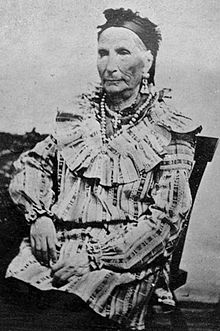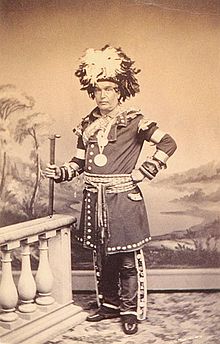Marguerite Vincent Lawinonkié
Marguerite Vincent Lawinonkié (* 1783 Bay of Quinte / Lake Ontario , Ontario ; † 1865 ) was a famous (art) craftswoman of the Wyandot . In 2008, she was named a Person of National Historic Significance by the Canadian government for the quality of her art .
Life
Lawinonkié was born in 1783 in the Wyandot community based on the north shore of Lake Ontario in Quinte Bay.
At the age of 24 she married Paul Picard Hondawonhont in the Indian reserve Wendake . Of all their children together, only the son Francois-Xavier Picard Tahourenche, who later became chief of the Wyandot, survived childhood.
Due to the life in the reserve and cut off from their traditional hunting grounds, it was increasingly no longer possible for the Wyandot to pursue their hunting and fishing life. Due to the increase in population in the reserve, fishing and growing maize and potatoes were no longer reliable enough to feed the people of the community.
At that time Lawinonkié supported the family with their needlework. Around 1830 she founded a craft business that quickly made a profit and employed most of the residents of the settlement. There snowshoes, boots, gloves and sledges were made for the soldiers of the army and moccasins, gloves, snowshoes, ash baskets and souvenirs for visitors. Embroidery techniques in particular were gradually refined and moose hair of different colors was used. Animal skins, red or black fabrics and birch bark served as the substrate for the complex work. Lawinonkié's snowshoes and moccasins , embroidered with porcupine bristles and moose hair, were known as far as Quebec and the United Kingdom . Her great success benefited the development of the local economy, and Lawinonkié pioneered the Wyandot handicrafts that enabled the community to make a living. In 1879, sixty of the seventy-six families in Lorette (now Wendake) were handicrafts, producing more than 30,000 handcrafted moccasins annually. The Wyandot community established itself selling their numerous handcrafted products while at the same time preserving and passing on traditional techniques and knowledge.
Lawinonkié died in 1865 and was buried in Wendake.
Honors and commemorations
- Some of her finest works, such as the headdress she made for her son, are preserved in museums.
- On April 25, 2008, Canada's National Museum of History and Society acquired some possessions from James Bruce, 8th Earl of Elgin , including snowshoes, two pairs of beaded moccasins, and two birch bark trays attributed to Lawinonkié.
- Your previous home has been preserved and converted into an information and cultural center.
- In 2008 the Canadian government awarded Lawinokié with the honorary title Person of National Historic Significance on the grounds: "Brought to light the quality of the work and creativity of the artisans of Lorette and today is among the rare known artisans associated with this quality production. "
Individual evidence
- ↑ see English Wikipedia: en: Persons of National Historic Significance
- ↑ Répertoire du patrimoine culturel du Québec: Vincent, Marguerite . Retrieved May 24, 2015
- ↑ a b Merna Forster: 100 More Canadian Heroines: Famous and Forgotten Faces . Dundurn Press, 2011, pp. 215-217
- ^ McCord Museum: The Huron-Wendat Craft Industry from the 19th Century to Today. Linda Sioui, Conseil de la Nation huronne-wendat
- ^ Library and Archives Canada: A Celebration of an Important Acquisition with Lord and Lady Elgin - What's New .
- ^ Directory of Federal Heritage Designations: Lawinokié, Marguerite Vincent - National Historic Person . Retrieved May 24, 2015
| personal data | |
|---|---|
| SURNAME | Lawinonkié, Marguerite Vincent |
| BRIEF DESCRIPTION | Canadian First Nations artist |
| DATE OF BIRTH | 1783 |
| PLACE OF BIRTH | Bay of Quinte, Lake Ontario |
| DATE OF DEATH | 1865 |

